I visited Cerne Abbas on an exceptionally cold Thursday in February. It was the day after a difficult professional qualification exam, and my mind was hollowed out. I was annoyed that an eBayer had failed to pay for an item of mine they’d bid for. I’d wished I’d bought good gloves this winter. I wondered if I’d get hungry. I was beset by the mundane trains of thought that make up daily reality.
Cerne Abbas is a special place, in the same camp as Glastonbury, Avebury, or any number of the West Country’s mystic hotspots. It’s also home to a well known geoglyph (not a petroglyph, as I recently learned) depicting a naked man-giant. Until the days of dissolution, Cerne Abbas was home to an abbey-brewery, which drew its water from the crystal clear springs of St Augustine’s Well. There’s still an avenue of timber framed medieval houses leading away from the former site of the abbey. For its quaint and genteel weirdness, Cerne Abbas is worth visiting.
The Wessex Ridgeway slopes down into the village, guiding walkers under the chalky giant’s feet and depositing them in the meadow that once housed parts of the abbey. Although gone, a few of the abbey’s outbuildings remain, and a church has served the religious needs of the village since the early 1300s.
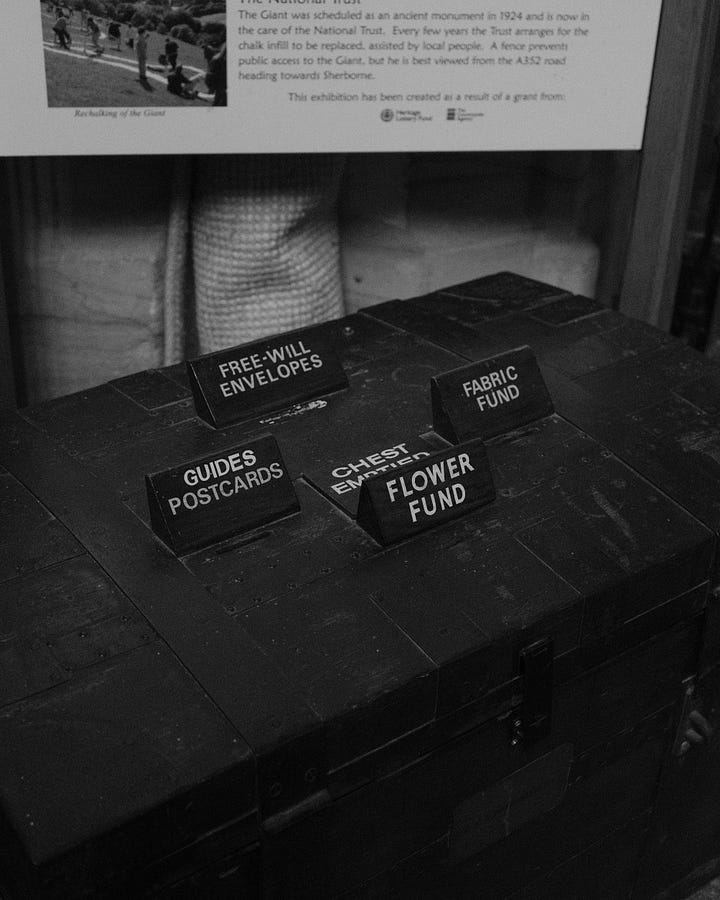

It was stepping into this church that prompted my thoughts on the specificity of the rural experience. I opened the hulking wooden door and was greeted by the smell of cold, damp velvet. The heavy red curtain, seemingly a ubiquitous feature of country churches across England, created a musty aroma so enduring that it may outlast the church building itself. I breathe in a few more times, confirming my theory: that this church in present-day rural Dorset smells exactly the same as the church on top of the only hill in East Essex, which I stood in 30-odd years ago.
To my left, another sumptuous red velvet curtain separated the entry cove from a haphazardly-installed kitchenette. Off-white kettle, mismatched mugs, a box fridge. Dishcloths. Caustic, acrid cleaning sprays. Somewhere in this kitchenette would be a half-opened packet of biscuits. They’d be custard creams. They are always custard creams. Never bourbons.
There is a typological sameness to these spaces that is unchanged by time, and possibly independent of geography. If you grew up rural, the community church kitchenette and its crap biscuits would have been an integral brushstroke in the slow-drying layers of your youth. Somewhere else in your memories will be twenty identical thick-outlined pictures of Jesus doing something, or being done unto; each will be coloured-in with furious felt tipped scribble, the leavings of some toddler group or Sunday school activity.
I mull these similarities over, reasoning that the relatable aspects of 90’s rural kid life likely cross county lines, merging into a wider English rural vernacular. Is it only England? I wonder if the pebbledash and cement-rendered Methodist chapels in Wales have shonky kitchenettes and disappointing biscuits, too.
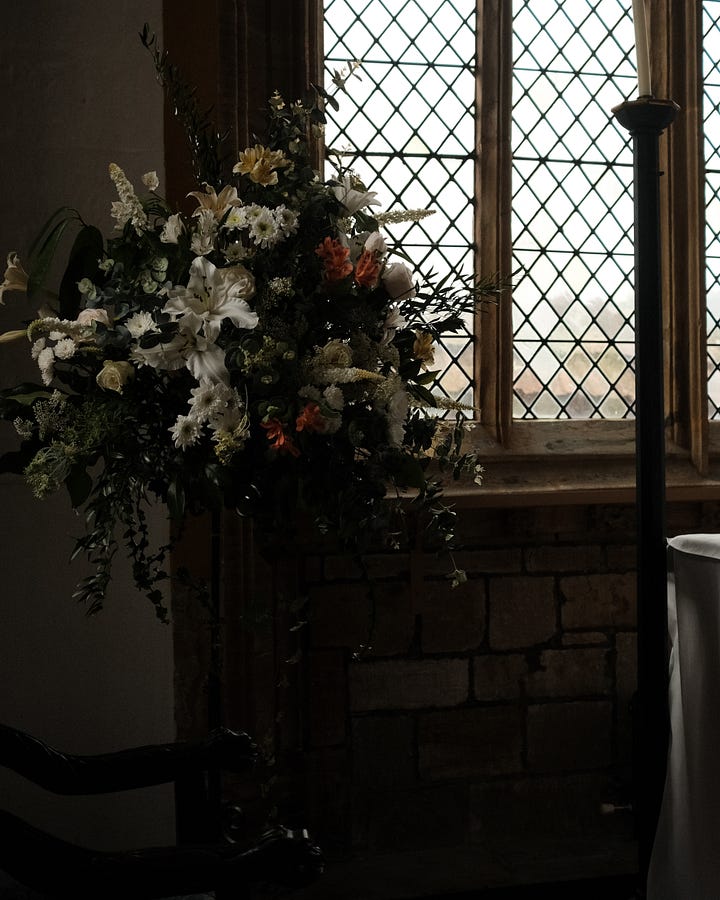
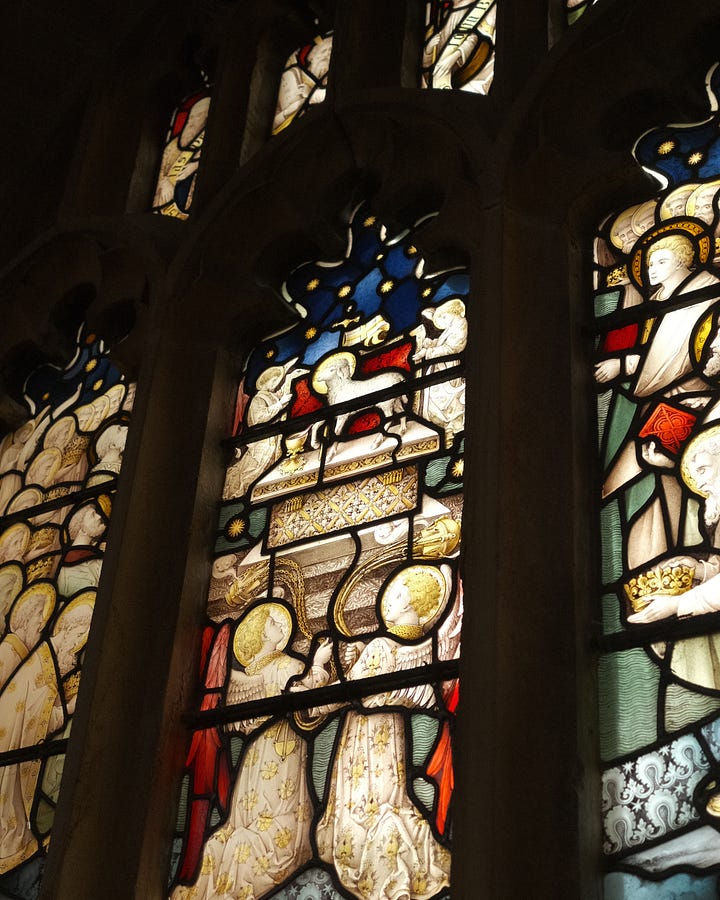
There isn’t a singular ‘English rural vernacular’, as the countryside’s built physicality is determined by the land itself. Ham stone for the houses in South Somerset, grey-green slate slabs for Cumbria. But in post-war England, agricultural buildings were mass produced to a blueprint, as were many village halls and community centres. The visual geographies had become compressed, like an accordion fold, by the sameness of mass manufacture.
Regionality both does and does not define rural England. There are some reliable specifics: fields, cows, the village shop, those musty churches, vegetable shows in summer usually held at the annual village fete. Church flowers. Charity cake sales. Harvest festivals for the primary school kids. The Maypole. Flaming barrels of tar, chasing wheels of cheese down steep hills, carrying wheels of cheese up steep hills, endless effigy burning. Here and now, though, the divergence of ‘the rural aesthetic’ is a result of ‘insider’ and ‘outsider’ perspectives.
While the popular contemporary view of rural England still leans on the visual identities of a John Constable construct, people who live and make art here and now are examining the visual signifiers of the rural with fresh eyes. Rural England is a place of both hyper-regional uniqueness and copy-paste typologies.
I’m one of many ‘rural returnee’ photographers using the camera to make notes on the more nuanced visual identities of rural and semi-rural settlements.
Jethro Marshall, of West Country Modern, is documenting the typologies of newer vernacular design throughout the West Country. Exactly a year ago, I visited Jethro’s exhibition at Bristol’s Serchia Gallery. Titled ‘Beautility’, the work features typological documentations of the West Country’s utilitarian vernacular. Agri-barns, new build churches, prefab village halls. I recognised a church flanked by Cordyline palms as one close to my grandmother’s former home in Poole. If you’re from the BCP region, you already know what it looks like. You’ve always known.
I also recognised one of the village halls documented in Jethro’s book, Halls & Oats - located in village I currently live in. As it turns out, Jethro grew up here, although a large gap in time meant our paths have never crossed.
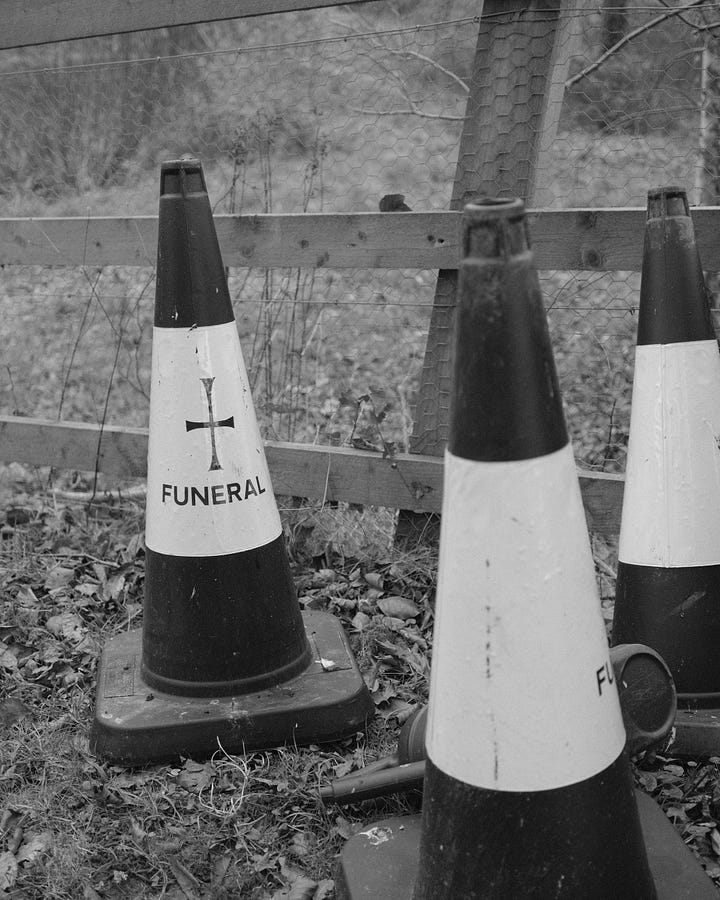

Echoing the ‘anti-bucolic’ sentiment of West Country Modern is Thomas James’ ‘Path Through Bath’ project. The work aims to dispute the tourism-driven ‘postcard’ depiction of the city of Bath, presenting images that highlight a blend of mundane-banal scenes, offering a fuller and more nuanced representation of Bath.
The reality of growing up rural is that it is often excruciatingly boring. However, it’s that boredom and the resulting need to make one’s own entertainment that has driven the character of rural communities through generations, for better or worse. The key element of understanding the rural vernacular is tied inexorably to growing up rural.
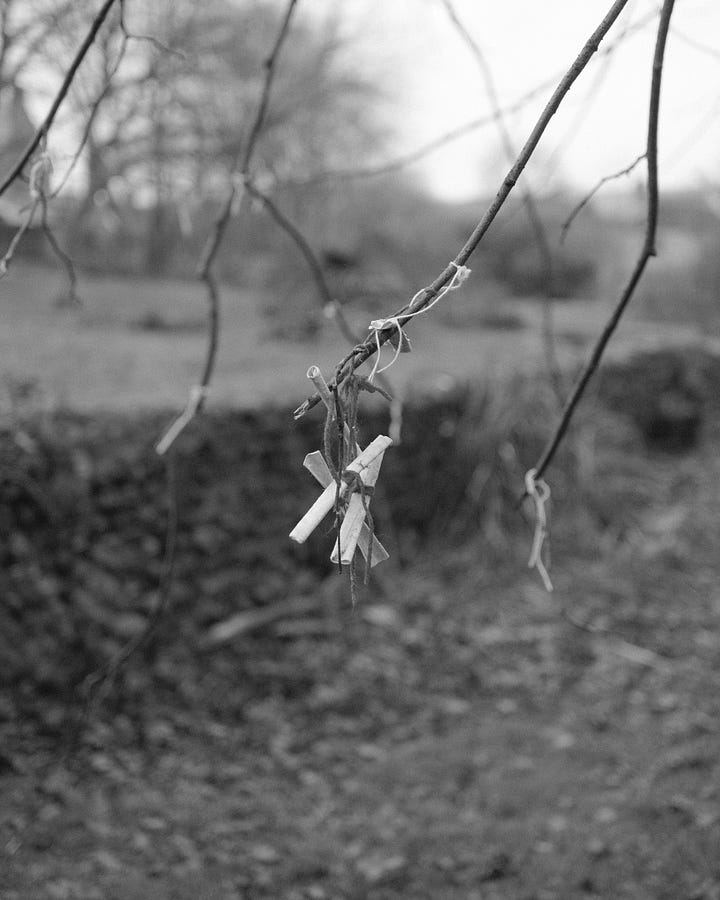
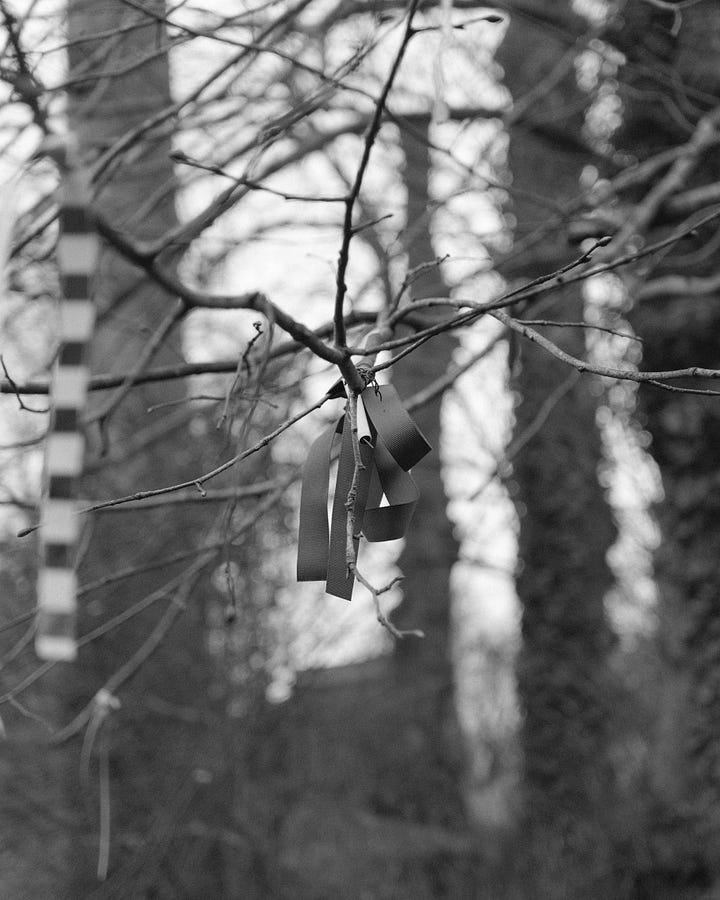
I think back to my youth in East Essex. Living in the estuary village of St Lawrence, attending the nearest primary school in Bradwell; locations separated by miles of grey-brown salt marsh. In the 1990s, school life adhered closely to the agricultural calendar. We’d dance the Maypole in May (duh) and have a harvest festival in September. As a Church of England (broke and rural) school, we’d attend a daily Bible-centric assembly in the morning before adhering to our various pagan rituals of woven corn crests and proto-Morris dances. It was a picture of normality for us, tradition with no questions asked.
Cerne Abbas is neither similar to or dissimilar from my home village, or any other village in England. I don’t yet know how it’s possible for physical places to inhabit mutually exclusive states of being, but they exist regardless. Churches, old buildings, a village shop with one of three signs (swing, front page, dairy). Headstones. A tree that someone’s grandparents sat under decades ago. Small traces of pre-christian habits and behaviours; ribbons tied to branches over a groundwater spring.
I’ve been wandering semi-aimlessly through the rural villages and in-between spaces of the West Country since 2022, when research images were required for my Master’s degree in photography. I was inwardly lost at the time, paralysed by the dismay of having returned from my wondrous but exhausting life in Kyoto and finding myself surrounded by mud and cows. I couldn’t see anything, despite the patient guidance of my course tutors.
Three years later, I’m able to appreciate the images made at that time. Restless, desolate. I’ve immersed myself in the visual components of gothic literary constructs to better relate to the complicated reality of being a ‘rural returnee.’ East Essex is dripping in horror, from the Witches of the Dengie to the dread remoteness of the salt marsh. West Dorset and South Somerset feel a little more bucolic, but this only deepens their complexity as places, requiring me to listen more carefully for hints of the strange.
I work on gathering material for projects as and when opportunities arise, and thankfully the research visits for Far Corners [2023-ongoing] are possible throughout the year. I’m finding influence in the American traditions of ‘regional gothic’ (the well-known Southern Gothic, New England Gothic and Midwestern Gothic literary genres and visuals), and being led primarily by the tradition of the ‘folk horror’, as it exists in the written word, cinema and in oral traditions. I’m searching for themes that tie into an idea of a ‘West Country Gothic’ - it may take a while.
Luddite’s Corner
Each month I’m reckoning with a different facet of a return to the offline world. I’m drawing lines between what I remember of Internet 1.0 (in all its static glory) and an enshittified contemporary Internet in late-stage entropy.
This month, the UK has been forced to confront the future of creative work in an online world which is awash with the output of generative AI. The work of UK (and other) creatives has been scraped from every corner of the internet in order to feed the rapacious greed of proprietary genAI services. As well as polluting our collective online space, the energy costs and cooling requirements of genAI’s required hardware is also tearing through electricity and water at a frightening rate. In terms of quality, it is an unabated race to the bottom.
What’s bring produced is slop. It’s Chinese brands like Shein and Temu’s fake ads for products that don’t exist. It’s the bizarre clickbait ads about one weird trick that doctors don’t want you to know. It’s low quality material for low quality consumption, and the output is only increasing. The majority of this output, however, did not materialise from a void. Mainstream culture was already sinking in the undifferentiated swill of reality TV, Facebook, and clickbait, and genAI hasn’t given anybody a tool to create something new and thought-provoking. It simply allows people to re-mix the low quality base materials which already permeate our visual norms.
In 2024 I gave up on finding meaningful income through writing. Editors now use AI programs to check that work submitted to them has not been generated with AI (pot, kettle). These AI content checkers are, without fail, inaccurate, and writers are often falsely accusing of using genAI - a wild double standard. Illustrators are having their entire digital catalogues scraped so that genAI users can steal their specific artistic style. Creative output is not only becoming impossible to make a living from; it’s seemingly punishable by a form of mass theft and consequent devaluation.
Translators and caption-writers are also being replaced by gen AI programs - the BBC, for example, hails this as ‘progress’ - corporate code for ‘not having to pay people.’ Human inputs, despite being the lifeblood of so much of the audio-visual world, are disposable when a few coins can be saved. The Beeb’s view on the issue can be found here. Oddly, it decries the abandonment of UK copyright law to allow unhindered data-scrapes, despite singing the praises of genAI for making captioners and translators redundant.
The ‘Make It Fair’ campaign by News Media UK is pushing for strong copyrights on the work produced by UK artists from all fields, at a time when it appears that the government is intent on siding with genAI developers in allowing The Great Scrape to overrun copyright law.
What are we to do? Can a mass withdrawal of artist labour even be considered? Will public tastes for genAI-slop sour once people have tired of the novelty? Does the general public even care?
I cannot escape the feeling that this is the grand culmination of the ethos of late-stage capitalism. That we must all consume, and only consume. People who do create are punished in the only way that capitalism can control: financially. Paid creative work is gradually becoming an option only for those of existing wealth privilege (much like healthcare, housing, and even the regular, shit kind of paid work). While demanding that our bitter disappointment of a government uphold copyright laws is a starting point, it feels almost humiliatingly futile.
Data-processing AI has clear uses: in medicine, in financial pattern analysis, in ecological population monitoring. Data-processing AI is indeed the tool that can improve human understanding and adaptability. But genAI offers absolutely nothing of value. Nobody needs to scrape a thousand hours of classic cinema or the complete literary works of the 20th century. There is no possible use for the output that such an operation would produce. It would simply wipe pay for creative work away entirely, replacing humanity’s one and only redeeming feature with post-entropy splatter.
Being ‘more offline’ won’t save cinema from being scraped, nor literature, and likely not art or sculpture, either. But this digital effluence is created for consumption - so we should consider how, when and if we consume it. It seems as though a large proportion of the world’s population may be happy to do so. Guzzle, guzzle, guzzle. Perhaps an entirely new, post-AI creative space is ready to be (and is already being) carved out by people prepared to make the effort.










